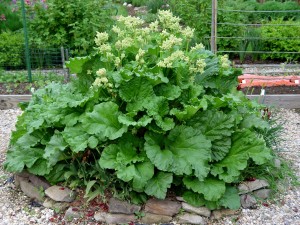Rhubarb
* Common name: Rhubarb
* Botanical name: Rheum palmatum
* What it is: An old-fashioned Pennsylvania Dutch favorite with stout, red, celery-like stems and large, green leaves the size of a pie plate. It’s grown mainly as an edible, but if you think outside that box, rhubarb makes a great, tropical-looking ornamental – especially when a few of its muscular white flower stalks poke up above the foliage in late spring. Stems are edible, especially in pies with strawberries. Don’t eat the leaves… they’re dangerously high in oxalic acid. Rhubarb is winter hardy and comes back year after year.
* Size: Bushy plants can easily grow 5 to 6 feet around and 4 feet high.
* Where to use: Striking as a centerpiece in a four-square vegetable garden but also ornamental enough to star in a flower bed or border. Does best in full sun. Will cry for mercy in soggy clay.
* Care: Harvest early May through early summer by twisting off largest stems at base. Pull off any yellow or brown leaves throughout the rest of summer and cut whole plant to ground when frost kills all foliage in fall. Spread light layer of compost or well rotted cow manure (Mmmmm) over the ground in fall, and that’s the only nutrition rhubarb usually needs. Some say cutting off the flower stalks is best if you’re shooting for maximum production.
* Great partner: Surround rhubarb with strawberry plants for a “pie bed.” Low-growing herbs such as thyme or oregano also are good partners.








